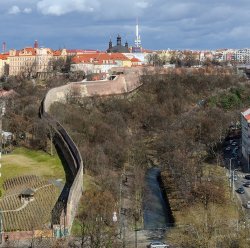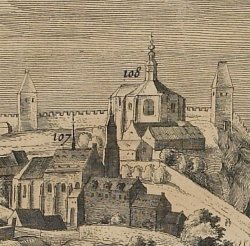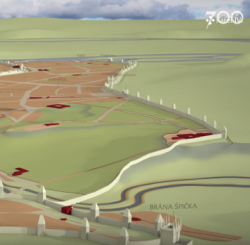Hradby Města pražského z doby Karla IV.
Cesta za historií Nového Města pražského nad údolím potoka Botiče

|
Praha 2, Nové Městov |
Folymanka - Na Slupi |
|
Dochovaná hradba opevnění Nového Města pražského z doby Karla IV. Jeden z nejlépe dochovaných úseků vrcholně středověkého opevnění Prahy s vyhlídkou z barokního bastionu. V poloze Na Slupi doloženo pohřbívání v době laténské i raném středověku, od přelomu 10. a 11. století i provozování řemesel |
|
Hradba ohraničuje od severozápadu volně přístupný park Folymanka mezi ulicemi Sokolskou a Na Slupi. |
|
pohřebiště i dílny u Botiče: http://praha-archeologicka.cz/p/295?q=Na+Slupi |
Založením Nového Města pražského Karel IV. inicioval, navrhl a fakticky realizoval správní, kulturní a hospodářské centrum střední Evropy, které svým rozsahem nemělo v celé Evropě průběhu 14. století obdoby. Počin založení a výstavby nepochybně představuje nejmohutnější středověké urbanistické dílo realizované v tak krátkém čase, jehož funkce kontinuálně přetrvala do našich dnů.
Současně se založením Nového Města pražského na ploše dosud málo osídleného prostoru za hradbami staroměstskými o rozloze asi dvou kilometrů čtverečních, začaly být budovány v roce 1348 i jeho hradby. Převážná část hradebního pásu tvořeného hradbou s věžemi a velkolepými branami a s výjimkou jižní linie také příkopem v průběhu dalších staletí ustoupila dalšímu rozvoji města. Jižní část gotických hradeb, situovaná na skalnatém hřbetu nad údolím potoka Botiče, zůstala díky terénní konfiguraci, nepříznivé pro hustší zástavbu, dochována ve velkém rozsahu. Na některých místech byla včleněna do mohutných staveb opevnění barokního. Linie opevnění, stoupající od toku Botiče až ke Karlovu, je dobře patrná z vyhlídek protějšího Vyšehradu.

Monumentalita, rozsah a členitost umožnily Karlovi IV. v rámci Nového Města uskutečnit řadu neopakovatelných urbanistických počinů. Jedním z nich byl záměr vybudovat nové stavby sakrální, koncentrované a symbolicky rozložené do tvaru kříže v klidné jižní části Nového Města. V levém horním vrcholu symbolického kříže vznikl na výběžku Břežské skály benediktinský klášter Na Slovanech u Nanebevzetí Panny Marie (Emauzy), který zakládali mniši pocházející z Dalmácie. V pravém horním rohu kříže, dnes okolí ulice Kateřinské, byl po roce 1353 vyzdvižen klášter augustiniánek obutých poustevnic zaslíbený patronce Karla IV. sv. Kateřině, kam byl v roce 1355 uveden konvent z Bavorska. V dominantní poloze nad údolím Botiče a v nároží města obklopena městskou hradbou vznikla po roce 1350 unikátní stavba kanonie augustiniánů na Karlově odkazující na karolinské tradice. Kostel byl zasvěcen Panně Marii a Karlu Velikému a zdejší kanonie byla programově provázána s dceřinou kanonií v Dolním Ingelheimu. Čtvrtý vrchol kříže vyplňoval konvent kláštera servitů u kostela Zvěstování Panny Marie na Slupi (na Trávníčku), který se nacházel na skalce vytvořené a původně obtékané meandrujícím tokem Botiče. Zdejší mariánský kult pocházel z Florencie a klášter byl otevřen v roce 1355. Pětici církevních institucí uspořádaných do kříže dotvářelo kolegium kanovníků s kostelem sv. Apolináře z roku 1362, jejichž úkolem bylo teologické studium a výuka na univerzitě (podle V. Kašpara, Průvodce pražskou archeologií, Praha 2018).

| délka úseku | popis úseku | cíl |
|---|---|---|
| ca 800 m | Ze zastávky MHD Ostrčilovo náměstí pešky ke Karlovu a baroknímu bastionu parkem Folymanka. Převýšení ca 40 m. | Barokní bastion - vyhlídkové místo zejména na Nové Město a Vyšehrad. |
| ca700 m | Z barokního bastionu s vyhlídkou zpět strmou Horskou ulící k zastáce MHD Albertov. | MHD Albertov |
Datum vložení: 14.3.2020 | Datum aktualizace: 15.3.2020
Autor: Ivana Boháčová
- I. Boháčová - J. Podliska a kol. 2018: Průvodce pražskou archeologií. Praha.